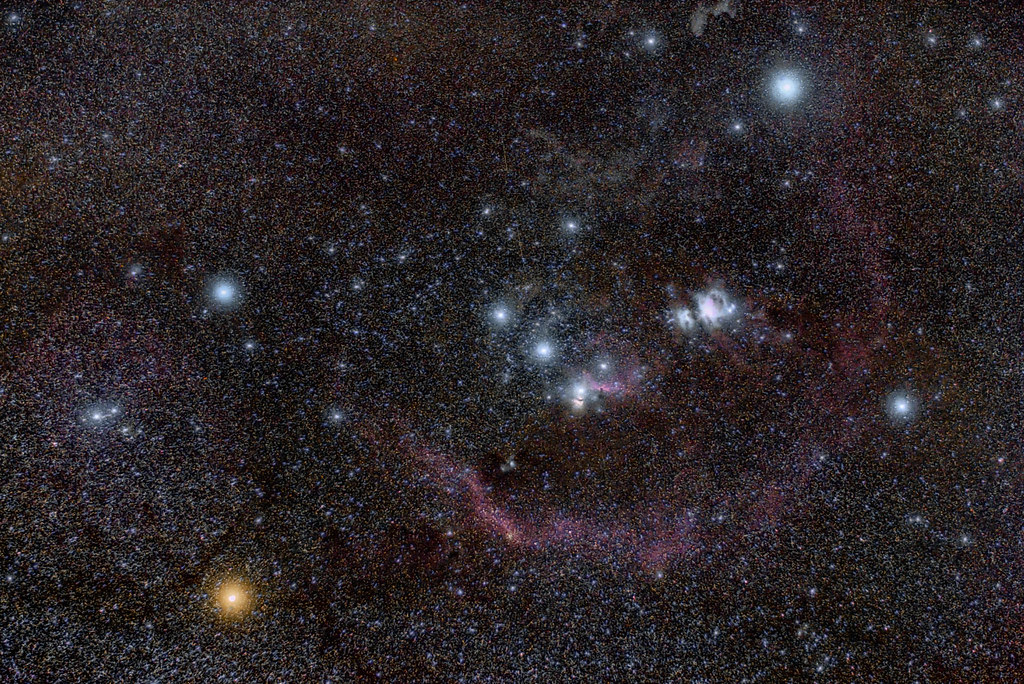BDanielMayfield wrote: ↑Wed Jan 23, 2019 8:48 pm
Cousin Ricky wrote: ↑Wed Jan 23, 2019 3:58 pm
APOD Robot wrote: ↑Wed Jan 23, 2019 5:07 amOrion has
looked pretty much the same during the past 50,000 years and
should continue to look the same for many thousands of years into the future.
Are we that sure that Betelgeuse won’t blow sooner than thousands of years from now?
Good point. No, we can't even be sure that Betelgeuse hasn't already blown up.
The time until Betelgeuse explodes depends on the predicted initial conditions and on the estimate of the time already spent as a red supergiant. The total lifetime from the start of the red supergiant phase to core collapse varies from about 300,000 years for a rotating 25 M☉ star, 550,000 years for a rotating 20 M☉ star, and up to a million years for a non-rotating 15 M☉ star. Given the estimated time since Betelgeuse became a red supergiant, estimates of its remaining lifetime range from a "best guess" of under 100,000 years for a non-rotating 20 M☉ model to far longer for rotating models or lower-mass stars.
So assuming that the "best guess" of less than 100,000 years is correct and that this star is about 600 light years away the odds that it has already popped is more than 0.6%.
Which means that the odds that it hasn't already popped are about 99.4%.
Jim Kaler has a lot of interesting (but quite uncertain) info about Betelgeuse.
Jim Kaler wrote:
The star's distance is a problem and a puzzle (true for all the other parameters as well). Direct parallax measures from space, using the most modern results, give 495 light years, whereas the parallax using the star's natural radio emission gives 640 light years. At a compromise distance of 570 light years, and allowing for a lot of infrared radiation and for absorption of light by circumstellar dust, the luminosity comes in at 85,000 times that of the Sun, considerably more than comes out of Antares. At the larger distance, luminosity boosts up to 105,000 Suns.
...
Moreover, because of changes in gaseous transparency, the "size" of the star depends on the color of observation. Long-wave infrared measures give a vastly larger radius of up to 5 AU and greater, as big as the orbit of Jupiter, while shorter-wave infrared light gives as small as 3 AU. Moreover still, infrared measures reveal Betelgeuse to be shrinking (by some 15 percent over about 20 years), and other measures show that the star is not even round, but somewhat oval.
...
Whatever the actual numbers, Betelgeuse is clearly a highly evolved star, one whose central hydrogen fuel supply has run out. As a result, the core has contracted into a hot dense state, and the outer portions swelled outward. We do not really know the star's condition at the moment, but the odds are that it is now in the process of fusing helium into carbon and oxygen in its core.
From theory, its initial mass should have fallen somewhere around 18 or 19 times that of the Sun. Starting life as hot, blue, class O star only around 10 million years ago, Betelgeuse will fuse elements through neon, magnesium, sodium, and silicon all the way to iron. The core will then collapse, causing the star to blow up as a supernova, most likely leaving a compact neutron star about the size of a small town behind.
If it were to explode today, it would become as bright as a gibbous Moon, would cast strong shadows on the ground, and would be seen easily in full daylight.
So Jim Kaler's best guess is that the initial mass of Betelgeuse was 18 to 19 solar masses. That's huge, but it is no record breaker by any means. If the uncertain parallax of "middle Belt star" Alnilam is correct, this blue supergiant is so bright that its initial mass may have been some
40 solar masses, double that of Betelgeuse.
We have of course every reason to believe that Betelgeuse is going to explode as a supernova, but we can't know when it will happen. My amateur opinion is that it is fun to speculate, but downright meaningless to "keep watching Betelgeuse and waiting for it to explode".
Supernovas are rare. No supernova in our own galaxy has been readily visible to the naked eye since 1604. The brightest Milky Way supernova in recorded history may have been the supernova of 1006 in Lupus.
According to Wikipedia, this probable Type Ia supernova exploded at a distance of some 7,200 light-years from the Earth, much, much farther away than Betelgeuse.
In my opinion, the chances that Betelgeuse will obligingly explode within the next 100 years or so at a distance of just some 600 light-years away and putting on a cosmic light show that has never been seen before in recorded human history, are slim.
Ann
 Orion over the Austrian Alps
Orion over the Austrian Alps
